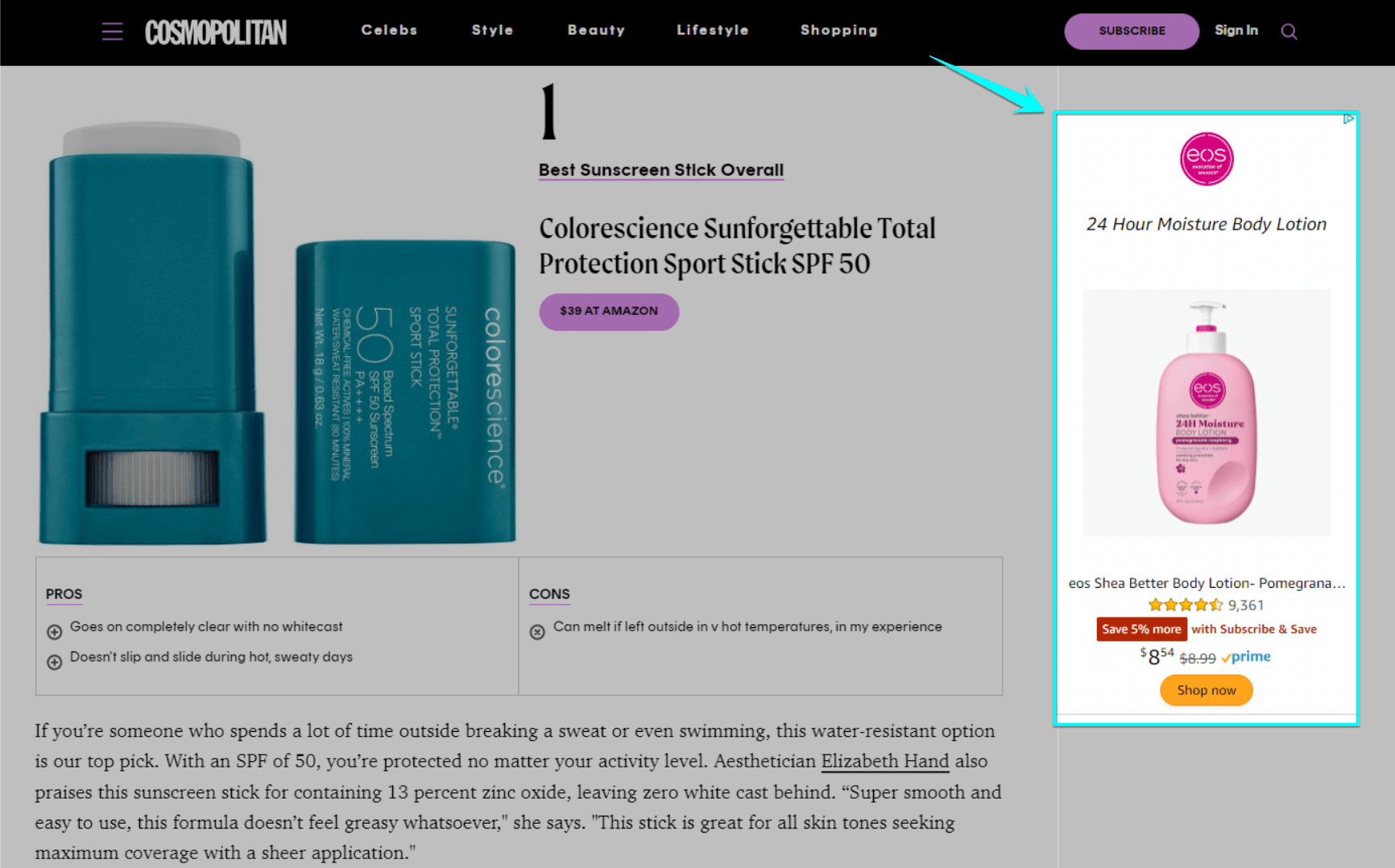- Home
- Digital Advertising
- Glossary
- What Is Display Advertising?
What Is Display Advertising? A Marketer's Guide in 2025
Display advertising definition
Display advertising is a type of advertising that promotes your brand, products, or services on third-party websites, apps, and social media platforms using image, video, and text elements.
Fun fact: People are 155% more likely to search for your brand online after they’ve seen your display ad. Display advertising is an excellent way to reach and engage your audience.
Understand display advertising and how you can use this strategy to grow your business with these topics:
- What is display advertising?
- 4 display ad formats
- 5 types of display ads (plus examples)
- 7 display advertising best practices
- Display advertising FAQs
You can also download our free digital marketing vs. traditional marketing guide to get experts’ tips on growing your business.
Digital vs. Traditional Marketing
Download this guide to understand the key advantages, costs, and opportunities for each to decide which is best for your marketing strategy!
Get My Free Guide
What is display advertising?
Display advertising is a popular form of digital advertising that promotes your business, products, or services on third-party websites, apps, and social media platforms using images, animations, videos, and text.
Businesses can run display ads to encourage targeted users to perform specific actions, such as:
- Visit a landing page
- Sign up for a newsletter
- Fill out a lead form
- Purchase online
Display advertising offers you the flexibility to reach a niche audience or a broader base of online users. In addition, you can also adjust your visual and text elements or call to action (CTA), while your campaign is running to maximize your budget.

4 display ad formats
You can use various ad formats for your display advertising campaigns:
| Display ad format | Definition | Best use case |
| Static ad | A non-moving and non-changing ad that uses image and text elements | For brand awareness ads and creating a key visual for your display ad strategy |
| Animated ad | An ad that uses various frames and animation | For conveying complex marketing messages |
| Interactive ad | An ad that encourages users to engage with the ad to reveal content | For providing an immersive experience for your audience |
| Video ad | An ad that uses audio and video to capture attention | For remarketing and nurturing previously interested prospects |
Let’s go through each one.
1. Static ads
A static ad is a non-moving ad that uses image and text elements.
The most common type of ad format, a static ad is typically saved as a JPEG or PNG file. Add this ad format to your mix to build a foundation for your display advertising strategy.
2. Animated ads
An animated ad is a format that uses multiple frames and animation along with text or audio elements.
This type of ad format can convey complex advertising messages. Animated ads are usually saved as GIF or HTML5.
3. Interactive ads
An interactive ad nudges users to engage with the ad to reveal what the ad is about.
It provides an immersive experience by encouraging users to click or drag elements, or use other interactive ad features. Interactive ads are typically built with HTML5.
4. Video ads
A video ad uses videos and audio to get the attention of online users.
Websites, apps, and social media platforms can all use video ads to promote your products or services.
5 types of display ads (plus examples)
There are various types of display ads, based on your target audience, how they work, and marketing channels. Here are the most common ones:
| Display ad types | Definition | Benefits |
| Banner ad | A common display ad that appears at the top, bottom, or sides of a webpage to get a user’s attention | Improved brand awareness |
| Retargeting ad | An ad that aims to re-engage users who have previously interacted with you by visiting your website or using your app | Nurturing your target audience |
| Contextual display ad | An ad on a website that’s aligned with the page’s topic or the user’s recent browsing history | Improved ad targeting |
| Pop-up ad | An ad that appears over a webpage | Improved conversions when executed properly |
| Interstitial ad | A full-screen ad that covers the webpage or app | Improved ad visibility and user engagement |
Let’s discuss each one.
1. Banner ads
A banner ad is a display ad that appears at the top, bottom, or sides of a webpage or app. You can use a banner ad for different campaign goals.
For example, when a user clicks on a banner ad, you can direct them to a landing page to provide more details about your product or special offer. You can also use banner ads to encourage users to sign up as a lead or purchase from you.
The example below of a banner ad is a static ad. You can also use animated, video, and interactive ad formats for this type of ad.

2. Retargeting display ads
A retargeting display ad is meant to re-engage users who have previously interacted with you by:
- Visiting your website
- Using your app
- Interacting with your social media page or posts
This display ad type is an excellent way to remind your prospects about their pending purchase or a product page they visited but may have forgotten about.
You may use different ad formats — static, animated, video, or interactive — to remarket to your audience.
Here’s an example of an in-app retargeting display ad. After playing the Wordle game in the NY Times app, the app encourages the user to try another in-app word game.

3. Contextual display ads
A contextual display ad is placed on websites relevant to the following:
- Ad’s topic
- Ad’s keywords
- Advertiser’s language and location preferences
- Website’s niche
- Site visitors’ recent browsing history
Display ad networks like Google determine the relevance of a website and ad.
Here’s an example of a contextual display ad display on a lifestyle website, which also covers skin care topics. The ad shown is about a product relevant to the topic on the page.

4. Pop-up ads
A pop-up ad is a display ad type that appears over a webpage. This ad type typically uses static, text, or interactive ad formats.
Make pop-up ads less obtrusive by setting rules to trigger their appearance. For example, you can set them to appear when a user has scrolled further down the page or when they’re about to leave the page.

5. Interstitial ads
An interstitial ad is a full-screen ad that covers a webpage or an app’s interface.
Because they take up the whole screen, interstitial ads immediately capture users’ attention. Interstitial ads can be static, animated, video, or interactive ads. They typically appear while a user is waiting for a page to load.
Here’s an example of an interstitial ad within a photo service app. When a user is ready to preview a product they’ve customized, a static interstitial ad encouraging them to upsell shows up.

How to create digital marketing display ads
Ready to start your display ad campaign? Here are the best practices you can implement. Make sure you use the correct display ad sizes!
7 display advertising best practices
Let’s go through each one.
1. Have a specific, measurable goal in mind
It’s important to set SMART goals whenever you start a marketing strategy, and this is especially true for display marketing.
Saying “I want to increase conversions” isn’t enough to tell whether you’re getting enough value from display advertising. Instead, consider setting a goal like “increase the number of leads for product X by 10% in two months.”
Those kinds of goals establish concrete numbers and progressions that you can follow to achieve success. And they’re much more measurable than something like “increase conversions.”
2. Look at all the available demographic data
It’s essential that you find out if your audience is available via a display network.
If you have a super-niche product or service, you may not find an audience that perfectly matches your ideal one on each network. And if that’s the case, you can cross some of them off your list of possibilities.
You should also check where all of the data comes from for a certain display network. If it’s based on tracking pixels and strategic offline gathering, that data is probably dependable.
If it’s unsourced, you may want to look elsewhere.
3. Use multiple marketing strategies
Display advertising is effective, but not as effective on its own as using multiple marketing channels at one time.
This means that you should establish or maintain your search engine optimization (SEO), pay-per-click (PPC) advertising, and social media strategies while you use display marketing for the best results.
This will give your brand more “real estate” online and allow you to reach out to customers that you otherwise would’ve missed by only using display advertising.
P.S. Need help implementing and managing your marketing strategies? WebFX can help! We offer a full suite of digital marketing services, including SEO services, PPC services, and much more!
4. Follow best practices for landing pages
While the design of your display ads matters, so does your landing page.
Your landing page, which is where users “land” after clicking on your ad, plays a significant role in whether a user follows through on your CTA. For your display ad marketing efforts to work, you need a fast, functional, and easy-to-use landing page.
Here are some landing page best practices you can implement:
- Build a responsive and mobile-friendly page
- Aim for a simple, no-fuss design
- Use your company’s branding
- Add trust signals like company awards, certifications, testimonials, and more
- Make your CTA stand out
When you follow these best practices, you create an attractive landing page for your audience.
5. Design simple and compelling display ads
Like your landing page, you want to use a simple and compelling design for your digital marketing display ads.
If you focus on designing a different, unconventional ad, it can lead to lackluster results. People may see your ad and have no idea what your company sells. Aim for a simple design and a compelling offer, and you can reach your target market with success.
Avoid overwhelming people with information, too. If you try to include too much information in your display ads, you’ll overwhelm and push people away.
Your audience won’t dissect your ad. Instead, they’ll go back to what they were doing, like reading an article or playing a mobile app.
6. Use programmatic advertising
Programmatic advertising is a useful strategy for your display advertising.
Programmatic advertising offers value because it uses a person’s immediate data, like their demographics, topic interests, and age, to deliver relevant ads. This feature can help your business advertise to the people who matter most to your company.
You can even use other factors, like the weather, to determine whether your ad shows up. This targeting feature can prove useful for companies depending on good weather, like a ski slope, amusement park, or golf course.
If you decide to use programmatic advertising, you can help maximize your company’s ad spend. You dedicate your ad spend to users with the most potential, like recent interest in your industry or products, versus anyone with history in those areas.
You can use programmatic advertising in-house or take advantage of programmatic advertising services.
7. Create a clear message and an attractive offer
Work on developing a clear message and an attractive offer for your audience.
At a glance, people should know what your display ad is about and what it offers them. A software company, for example, may promote a free 14-day trial. In comparison, an ecommerce store may advertise a holiday sale.
If you’re remarketing with your display ads, you can also incorporate audience data into your message and offer. Audiences that looked at a product, for instance, may see a display ad with the product’s photo and price.
Brainstorm a range of options before deciding on your messaging and offer.
Display advertising FAQs
Got other burning questions about digital marketing display ads? Let’s go through them here:
Digital marketing display advertising FAQs
1. What are the benefits of display advertising?
Businesses will benefit from implementing display advertising strategies. Here are some of them:
- Increased reach and brand awareness: Display ads let you reach audiences on various platforms and websites. While not every user will click on your display ad, site visitors who see these prominent display ads become aware of your business and offerings.
- Improved ad targeting: Digital marketing display advertising enables you to show your ads to audiences that fit the criteria you set. As a result, your ads are shown to users who are likely your target audience.
- Retargeting: Do you want to nudge existing users who previously engaged with your business to revisit your website or repurchase from you? Display ads can retarget these users and encourage them to take the next step to engage with your business.
- Measurable results: Display advertising informs you of your ads’ key metrics to analyze their performance, such as reach, impressions, click-through rate (CTR), and conversion rate. As a result, you can measure your return on investment (ROI).
2. Display vs. native ads: What’s the difference?
Display and native ads differ in their look and how they blend well with a website’s or app’s content.
Display ads are meant to stand out on a page. These ads’ elements — such as color, branding, and typography — are designed to catch the attention of the user, away from the page’s content.
On the other hand, native ads are designed to blend well with the website or page’s content. These ads have an editorial look and use a soft-sell approach.
3. Display vs. search ads: What are their differences?
A display ad appears on websites and apps while users are consuming online content or using apps. Meanwhile, a search ad appears on search engine results pages (SERPs) based on a user’s query.
That said, display ads are “push” advertising. When a user is reading a webpage or browsing social media, a display ad “pushes” a product or business.
On the other hand, search ads are “pull” advertising. When a user searches for a topic on a search engine, a relevant search ad appears, “pulling” users to a landing page.
Because of the nature of display ads, they’re suitable for brand building and boosting awareness. Meanwhile, search ads are useful for businesses that need to reach people who are proactively searching for their offerings.
4. What are the most popular display ad networks?
The most popular display networks are the following:
3 popular display ad networks
All three can display your ads on websites and apps that are opted into their network. Let’s go through each one:
1. Google Display Network
The Google Display Network (GDN) is probably the most well-known and popular choice. GDN is a group of websites, apps, and videos where your Google ads can appear.
You create and use Google display ads to reach potential customers worldwide.
2. Meta Audience Network
Meta Audience Network is Google’s biggest competition as far as display ads are concerned. Meta offers just as many options for its advertisers, and they even have a suite of tools that you can use to design the perfect display ads.
This ad platform enables you to reach billions of users across Meta’s apps, including Facebook and Instagram.
3. X (formerly Twitter) Audience Platform
The X Audience Platform is another platform advertisers can use. Just like the previous two options, X’s ad platform is designed to take your ads and promote them throughout the Internet, including mobile apps.
5. How do I measure the success of my display ads?
No matter what kind of marketing or advertising strategies your business invests in, you want to measure the performance of your efforts. When you take a proactive approach to campaign monitoring, you can improve and make the most of your digital display advertising.
Three metrics you want to look at when assessing your display ad performance include:
Display ad metrics to track
Let’s discuss each one.
1. Impressions
Impressions are a helpful metric for display advertising because they show how many people saw your ad. This metric can provide perspective on your audience size, as well as your click-through rate (CTR). In some cases, your business may expand your audience to broaden your audience and impressions.
2. CTR
In display advertising, CTR earns the most attention from marketers. That’s because your CTR shows the percentage of people who clicked on your ad.
In most cases, this rate is less than 5%, though every industry is different. Look at your industry averages and aim for those numbers.
3. Conversions
Conversions are another digital marketing metric to check. Your conversions tell you how many people converted.
Depending on your display ad campaign, conversions may range from clicking on your ad to 1000 people viewing your ad. Use it to see how well your display ads and landing pages work together.
Our digital marketing campaigns impact the metrics that improve your bottom line.
See Our Approach
$10 billion

24 million

7.14 million
Level up your display advertising strategies with WebFX
When planned and executed well, display advertising can effectively promote your business and offerings among your target audience.
If you need help with your display advertising strategies, consider teaming up with WebFX. We’re a full-service digital marketing agency with 25+ years of experience.
Our experienced and award-winning team of experts is excited to learn about your business, industry, and goals so we can create display advertising strategies that drive results and grow your bottom line.
Contact us online or call us at 888-601-5359 to speak with a strategist about our digital advertising services!
Table of Contents
- What is display advertising?
- 4 display ad formats
- 1. Static ads
- 2. Animated ads
- 3. Interactive ads
- 4. Video ads
- 5 types of display ads (plus examples)
- 1. Banner ads
- 2. Retargeting display ads
- 3. Contextual display ads
- 4. Pop-up ads
- 5. Interstitial ads
- How to create digital marketing display ads
- 1. Have a specific, measurable goal in mind
- 2. Look at all the available demographic data
- 3. Use multiple marketing strategies
- 4. Follow best practices for landing pages
- 5. Design simple and compelling display ads
- 6. Use programmatic advertising
- 7. Create a clear message and an attractive offer
- Display advertising FAQs
- 1. What are the benefits of display advertising?
- 2. Display vs. native ads: What’s the difference?
- 3. Display vs. search ads: What are their differences?
- 3. What are the most popular display ad networks?
- 1. Google Display Network
- 2. Meta Audience Network
- 3. X (formerly Twitter) Audience Platform
- 4. How do I measure the success of my display ads?
- 1. Impressions
- 2. CTR
- 3. Conversions
- Level up your display advertising strategies with WebFX
Related Resources
- What is an Ad Exchange? (+3 Types of Ad Exchanges)
- What is an Ad Network and How Does It Work?
- What is Behavioral Retargeting?
- What is Digital Advertising?
- What is Dynamic Keyword Insertion (DKI)? Everything You Need to Know in 8 Minutes
- What is Ecommerce Digital Advertising and How Does It Work?
- What is Facebook Advertising? Everything You Need to Know
- What is Live Shopping and How Does Live Stream Shopping Work?
- What is Online Advertising? Your Introduction to Online Ads
- What is Social Media Advertising? Boosting Engagement with Social Media
Marketing Tips for Niche Industries
- Urgent Care Marketing Ideas: 5 High-ROI Tactics
- Vision Care Industry Statistics
- Vision Care Industry Statistics
- WebFX: Your Education Digital Marketing Agency
- What is Patient Acquisition Cost & How Do You Calculate It?
- Why Auto Part Retailers Need Digital Marketing
- Why Digital Marketing is Essential for Auctioneers
- Your 2025 Guide to Digital Marketing for Home Security Companies
- Your Guide to Digital Marketing for Exercise Equipment Companies
- 2025 Professional Services Trends: Embracing the Future
